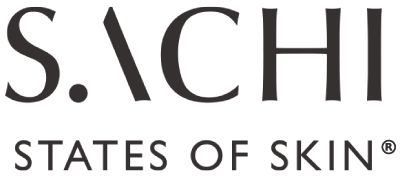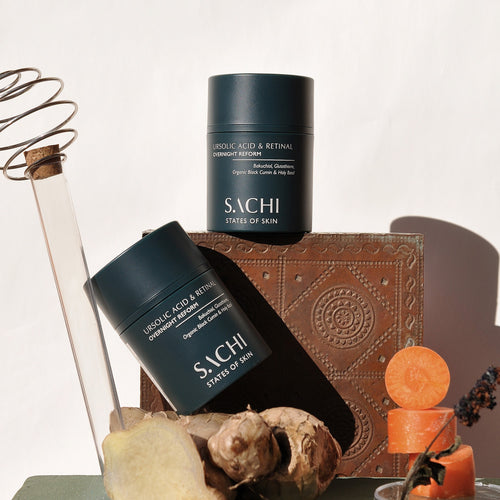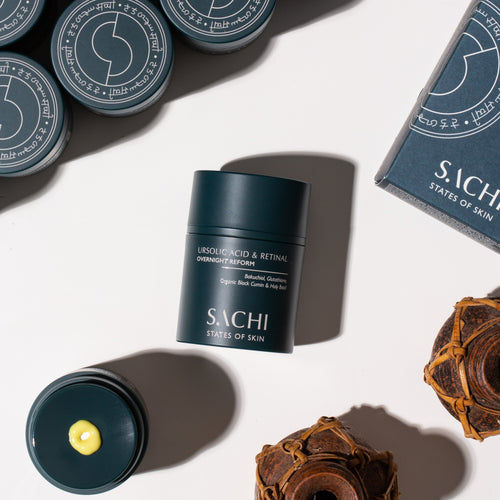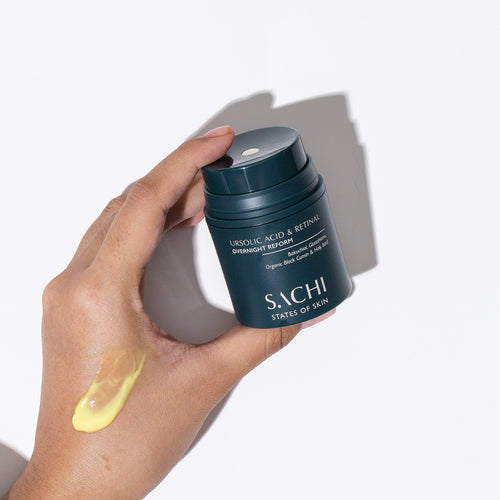7 min read
Retinoid Series
We know that incorporating Retinoids into your routine for the first time can be challenging or even scary for some. If a product is not properly formulated or used incorrectly, it can lead to skin irritations and an overall bad experience. This series is really about correct routine usage and eliminating fears so you can confidently use this ingredient in your routine with ease.
In our previous posts, we’ve talked about the benefits of retinoids, how to begin using them and debunked some misconceptions. In this last part of our Retinoid Ingredient Series, we provide a step-by-step guide to using Retinoids in your daily routine and talk about some effective combinations when layering.
Now whilst Retinoids (like retinaldehyde) have amazing skin benefits like targeting signs of ageing, acne, fine lines and wrinkles, they are often accompanied by skin irritation like dryness, flaky skin, soreness, redness, stinging sensations which can drive some users away. Interestingly, retinoids are better paired with some ingredients to minimise skin irritation and further optimise its benefits.
Here are three steps to incorporating retinoids into your routine and pairing them well with other ingredients to get the best skin results for you minus all the negatives:
Step 1: Choose the Perfect Retinoid Ingredient Pairing For You
To reduce irritation opt for:
Retinoid + Barrier supporting ingredients (Niacinamide, Ceramides, Oat Oil)
Retinoids irritation is often caused by impaired barrier function so pairing it with hydrating, nourishing and soothing ingredients is perfect to support the barrier and reduce the risk of irritation and redness.
Studies have shown that improving skin barrier function during the application of retinoids could reduce the risk of skin irritations. A clinical study has shown that cream with niacinamide enhances skin barrier function before application of 0.025% Vitamin A and significantly reduces the skin irritation such as dryness or peeling, burning, and stinging. [1]
To reduce dryness opt for:
Retinoid + Hydrators like (Hyaluronic Acid, Glycerin)
Dryness, irritation, redness and flaky skin can be an absolute nightmare for makeup lovers — this is where hydrators can really help!
A study reported that retinoid acid can cause significant trans-epidermal water loss (TEWLs) that can further impair skin barrier and induce more skin irritation [3]. A combination of retinoids and humectants such as niacinamide, panthenol, glycerin, and hyaluronic acid can help slow down TEWLs during application of retinoid. Hyaluronic Acid is an excellent ingredient to alleviate some of these concerns. As a humectant, it works by attracting and retaining moisture from the surrounding environment, increasing skin hydration and soothes the skin at the same time. This combination works well in one formula or when layered separately too.
To improve visible signs of photoaging, opt for:
Retinoid + AHA
It is a common misconception that Retinoids + AHA/BHA cannot be used together in a routine. When not properly formulated or used incorrectly, this pairing does make a very strong combination that can cause irritation, dryness or even worsen the skin barrier, especially for sensitised or sensitive skin. However, it is common to experience some irritation when using retinoids as the skin takes time to get acclimated to this potent ingredient. Furthermore, those who have more resilient skin or those of an older age may find this potent combination to be an excellent pair for more transformative results.
In a previously mentioned study [2], a double conjugated retinoid cream containing retinoate ester and AHAs such as lactic acid and glycolic acid showed better tolerability and efficacy compared to 1% traditional retinol. So yes, retinol and AHA/BHA can complement each other.
That being said, you should always patch test before use and start at low concentration and gradually increase as tolerated, if irritation persists, please discontinue. Also, always remember to apply sunscreen regularly as both can potentially increase skin irritaion and sun sensitivity.
This combination can give some great skin smoothing results, but since it does run the risk of irritation, we recommend that they are best layered on alternate days or used in moderation. At Sachi Skin, we have our Complexion Clarifying Accelerator Enzyme Exfoliant which can be layered or used on alternate days. This way, you stay in control of your active skin care routine and avoid the risk of over exfoliation.
To boost the antioxidant effect opt for:
Retinoid + Antioxidants (Glutathione, Vitamin C, Superoxide Dismutase, Silymarin, Bakuchiol)
Powerful antioxidants like Superoxide Dismutase, Glutathione and Vitamin C are great during the day as they help protect the skin against environmental aggressors and UV Rays alongside sunscreen. Furthermore, they can also supplement a retinoid evening routine for amplified results to repair, protect and brighten the skin. Just pay attention to skin sensitivities if you are pairing this with a Vitamin C and if there are any issues, scale back your use and frequency or stop use.
To target acne opt for:
Retinoids + Anti-Bacterial agents like Benzoyl Peroxide or Clarifying Botanicals
Both Benzoyl Peroxide and retinoids are great for effective acne-fighting ingredients, but when used improperly, it will likely increase skin irritation. Benzoyl Peroxide (a strong C. acnes bacteria fighting ingredient) has been assumed to induce oxidations and degradation of retinoid molecules, thereby reducing its effectiveness. However, this does not necessarily apply to all formulations.
A study done by Del Rosso et al. found that there is no degradation of Vitamin A when optimized formulation 0.05% Vitamin A is mixed with 6.25% benzoyl peroxide [4]. A great way to use Benzoyl Peroxide in a retinoid routine is to use this ingredient in a cleanser just before you layer your retinoid. This allows you to reap the antibacterial benefits of Benzoyl Peroxide without irritating your skin. Pairing retinoids and Clarifying botanicals like Black Cumin Oil, Silymarin, Neem is also great as studies have shown that they reduce microcomedones and blemishes with consistent use. Here at Sachi Skin, we also opt to use Retinaldehyde rather than Retinol which has strong antibacterial properties working against C. acnes bacteria.
Nevertheless, when it comes to acne treatment, it is best to consult with a dermatologist first.
Step 2: Start Simple and Slow - PM Retinoid Routine
It can be overwhelming to add retinoids into your routines especially if you are new to them. Here’s a simple routine that we have created as a guide for you to use while learning to incorporate Retinoids into your routine:

The rule of thumb is to always start simple. Incorporate retinoids with hydrating and moisturizing ingredients and avoid drying ingredients in the same routine as it can lead to higher risk of irritation. As your skin adjusts to it and needs an extra boost, you can layer them with other active ingredients as mentioned above. Remember to always listen to your skin. If irritation persists, please discontinue use.
Step 3: Choose the Right Formulation
It is equally as important to choose the right formulation as it is to look for the best combination. When not properly formulated, some can experience skin irritation to traditional retinoid formulations.
First, look for the right Retinoid type for your skin. In general, the more conversion steps required, the less potent and less irritating they are. Second, look for products formulated with combinations of ingredients that can lower the risk of irritancy and further boost its benefits and stabilise the retinoids. As mentioned, ingredients that hydrate and strengthen the skin barrier significantly reduce skin irritation and further boost the benefit, so it is always a good start to find products formulated with these actives to reduce the need for layering, making it simple. Lastly, look for an airless container to house your Vitamin A to retain its potency and efficacy as you continue to use over the months — the last thing you want is your retinoid to stop delivering its amazing results!


Our Ursolic Acid and Retinal Overnight Reform contains Retinal, which is a one-step conversion from Retinoic Acid, meaning it works faster and is more potent than the popular retinol yet since it is formulated in a skin supportive base of Oat Oil, Hyaluronic Acid and Niacinamide it is absent of the usual side effects. Retinaldehyde has powerful antibacterial properties and is the only retinoid to possess strong antibacterial activity working against C.acnes bacteria. It is also packed with ingredients like Niacinamide, Hyaluronic Acid, Oat Oil, Bakuchiol, Glutathione other antioxidants and peptides, providing a 360 degrees potent brightening and antioxidant protection whilst leaving the skin hydrated and supple.
Click here to find out more.
Reference
[1] Draelos, Zoe Diana, Keith D. Ertel, and Cynthia A. Berge. "Facilitating facial retinization through barrier improvement." CUTIS-NEW YORK- 78.4 (2006): 275.
[2] McDaniel, D. H. (2017, December 1). Efficacy and tolerability of a double conjugated retinoid cream vs 1.0% retinol cream or 0.025% Vitamin A cream in subjects with mild to severe photoaging. Wiley Online Library.
[3] Song, Xiuzu, et al. "Nicotinamide attenuates aquaporin 3 overexpression induced by retinoic acid through inhibition of EGFR/ERK in cultured human skin keratinocytes." International journal of molecular medicine 22.2 (2008): 229-236.
[4] Del Rosso, J. Q., Pillai, R., & Moore, R. (2010). Absence of Degradation of Vitamin A When Benzoyl Peroxide is Combined with an Optimized Formulation of Vitamin A Gel (0.05%). The Journal of clinical and aesthetic dermatology, 3(10), 26–28.



